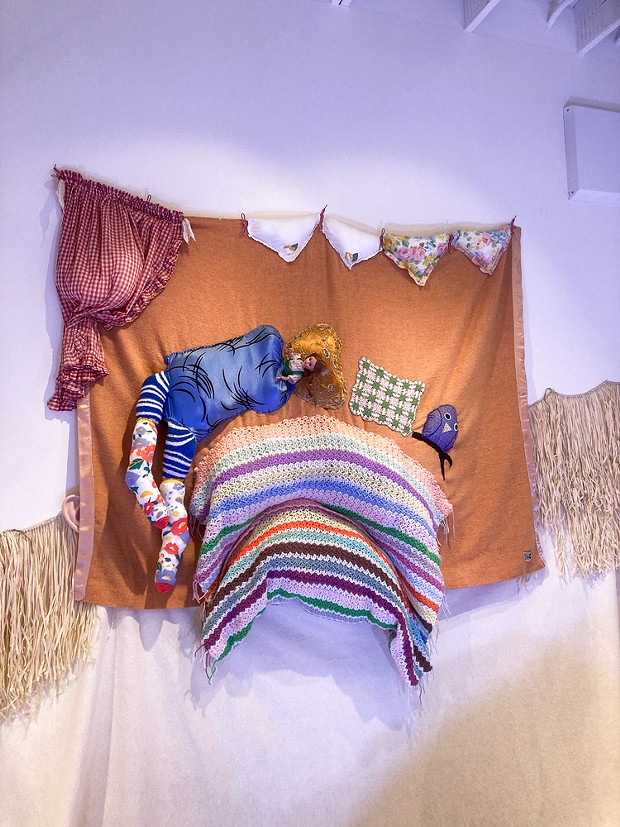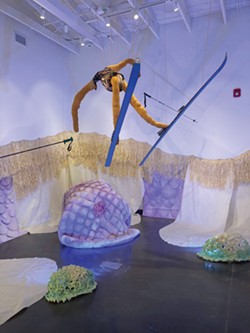
A doll sleeps in a fabric tableau in Nancy Tobin's CRy-Baby installation.
[
{
"name": "Top Stories Video Pair",
"insertPoint": "7",
"component": "17087298",
"parentWrapperClass": "fdn-ads-inline-content-block",
"requiredCountToDisplay": "1"
}
]
Some artists are world-describers, tirelessly reconfiguring surfaces, objects and spaces to resonate on a particular frequency. That's how it is with Nancy Tobin, whose installation CRy-Baby is on view through March 1 at College of the Redwoods. Subtitled "A comedic installation exploring the connections between space, past and future selves," the work delivers. "We're very excited for Nancy Tobin's CRy-Baby to be the first exhibition in the new Floyd Bettiga Gallery at CR's Creative Arts Complex," Gallery Director (and Journal contributor) Lindsay Kessner stated. "This opening exhibition highlights relationships we aim to nourish between the vibrant CR art community and the larger art world of Humboldt County."
Tobin has exhibited extensively in recent years, making installations on city streets, in galleries and pop-up retail spaces, in hotel rooms and her own home, outside at the Outer Roominations site-specific sculpture festival and indoors at the Morris Graves Museum of Art. At College of the Redwoods, she has created a softly illuminated, corner-less room/womb that's part boudoir and part theme park, reinventing this space as an outpost of her own creative sensibility. Imagery is playful and domestic, much of it stitched together by the artist from fabric cutouts. The fabrication is superficially naive and strictly DIY. Clouds are made from vigorous scribbles of extruded foam insulation applied to wire armatures. A Barbie sleeps in a rainbow-shaped bed made by stuffing a length of violently colored crochet and tacking it to the wall. A flat, linear depiction of the house where the doll sleeps gives way to a pillowy surface made up of individually stuffed and sewn fabric pods. The environment radiates love for the late 20th century's shiny, synthetic, domestic detritus — from polyester crocheted doilies to plastic hula skirts to quilted bed jackets to floral-print tube socks. Drifts of white felt on the walls look like snowscapes; faux foliage evokes the desert. The whole zany, corny, giddy, messy and excessive experience describes an interconnected way of existing that's unabashedly maternal. Entities are mutual interdependent. Umbilical cords (which are everywhere) don't get cut, they get bedazzled. Surfaces are undisciplined: soft and lumpy, quilted and cushioned. Boundaries are porous: Childhood memories bleed into adult forebodings and Okinawa segues into suburban Southern California.
When she's not making installation art, Tobin curates women's and men's wear at her Arcata boutique Vintage Avenger. She has a connoisseur's eye for the decor elements that crowded late 20th-century Boomers' homes, festooned their parties, entertained their children and documented their glancing acquaintance with other world cultures. Her chosen materials are female-identified and many of them started out as DIY textile projects and thrift-shop finds. A very partial materials list for CRy-Baby includes bronzed baby shoes, machine-embroidered tablecloths, quilted bedspreads, miniature gingham curtains, macrame plant holders, artificial foliage, a silk cheongsam robe and an appliquéd cartoon bird. Check these elements out, arranged along your path in idiosyncratic formation like so many tableaux on Disney's Pirates of the Caribbean ride. Puffy cursive writing made from extruded spray insulation states the exhibition title. An oversized, crocheted can of the diet soda Tab wears a purple princess petticoat and has been tenderly tucked into a doll's bed. Soft sculptures shaped like a pair of first-generation Fisher-Price baby monitors from the 1970s slump under their own weight. Two more soft sculptures suspended from the ceiling present caricatural self-portraits of the artist in youth (a headless sock puppet, flying down a mountain on skis) and advanced age (a gonzo crone sporting a walker and luxuriant silver pubes, struggling uphill).
The installation soundtrack, a staticky recording of military surveillance chat, evokes Tobin's experience growing up. During her childhood years, her pilot father's deployments took the family to 14 U.S. Air Force bases around the world. Home was an enclave of American comfort and consumer choice, set down in the middle of a shifting foreign landscape where cultural differences were constant, but fungible. Surveillance was a feature of base life — its presence initially comforting and later disconcerting. There were moments of fissure in which compartmentalization gave way to contact with underlying realities.
As a child in Okinawa in the early 1970s, Tobin and her friends would sometimes sneak off the base to play. Escaping a simulation of small-town America, they found themselves in an overgrown jungle landscape still riddled with caves, tunnels and bunkers left over from World War II. The jungle, haunted by its wartime ghosts, existed alongside the neat ranch houses inside the perimeter fence. The soft, lumpy figures in Tobin's installations are draped in elements of appropriated clothing that speak to this dislocated existence and the privilege that sustained it: beaded caps resembling those from Indigenous cultures, cheongsam and blankets printed with "Native American" patterns in blinding technicolor hues.
CRy-Baby rambles inside and outside the gallery walls, sending fringed translucent ducting all over College of the Redwoods' new, triangle-shaped Creative Arts complex. These conduits, which appear to run above and below ground, connect the Floyd Bettiga Gallery to the centrally located lecture hall. The wide-bore, industrial ducting with its fun fringe evokes potential for contagion and transmission, alongside incongruous "Blue Hawaii" vibes. An overhead view of the installation in maquette makes the umbilical nature of the buildings' liaison apparent.
Several years ago, Tobin sewed a set of prehensile cords she featured in a series of guerrilla art installations, posing and photographing them in public places. One photo from this series shows the cords on the move, slithering into or out of a supermarket display of egg cartons — possibly, looking for love. That image resembles a miniature prototype for CRy-Baby, in retrospect. Here, the artist has space to elaborate her theme. Her assemblage gives viewers a way to imagine existing in a place where time- and sightlines are consistently elided, and where identity is self-evidently plural. Instead of waiting passively for severance, umbilical cords seem to assert their agency at a distance. No longer autonomous, the gallery becomes one unit in an interactive system. Spaces are linked, not in a system of equal exchange, but in a system defined by maternal giving and mutual support.
Admission to the Floyd Bettiga Gallery at College of the Redwoods is free. The gallery is open to the public Tuesday through Thursday from noon to 4 p.m., and by appointment. For more information, visit redwoods.edu/artgallery.
Gabrielle Gopinath (she/her) is an art writer, critic and curator who lives in Arcata. Follow her on Instagram at @gabriellegopinath.
Editor's note: This story has been updated with the revised closing date for the exhibition.Speaking of...
-

University Police Investigation Clears CR Baseball Players of Assault Allegation
Feb 9, 2024 -

'First in the Country': Incarcerated Students in CPH Degree Program Now Eligible for Federal Financial Aid
Jan 29, 2024 -

Cal Poly Police Investigating Alleged Assault of Palestine Supporter
Oct 31, 2023 - More »
more from the author
-
Truth Units
Bachrun LoMele's Burn Pile/The Andromeda Mirage at the Morris Graves
- Sep 7, 2023
-
Ruth Arietta's Illusory Interiors at Morris Graves Museum of Art
- Aug 10, 2023
- More »
































